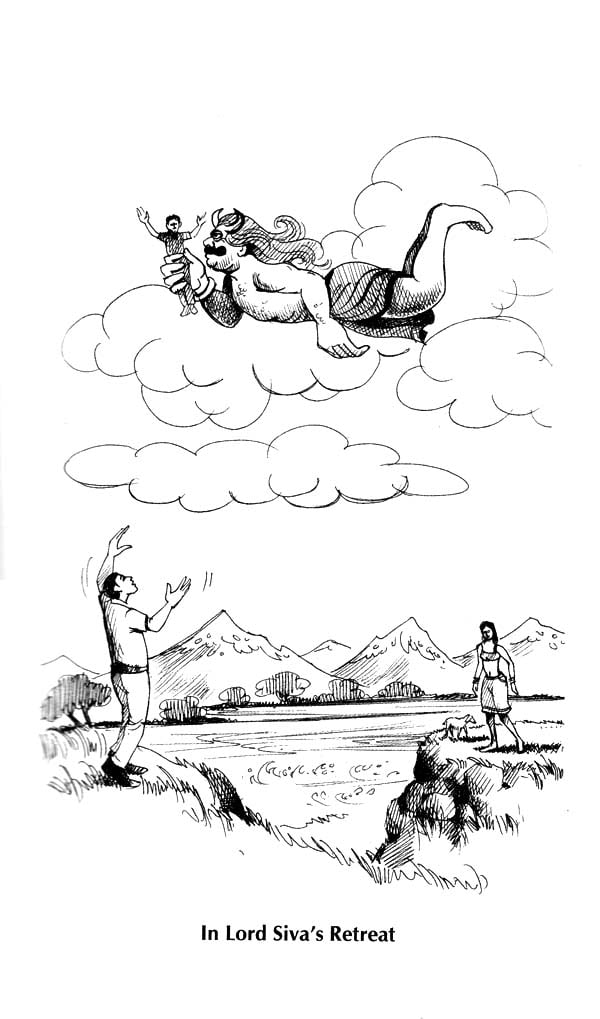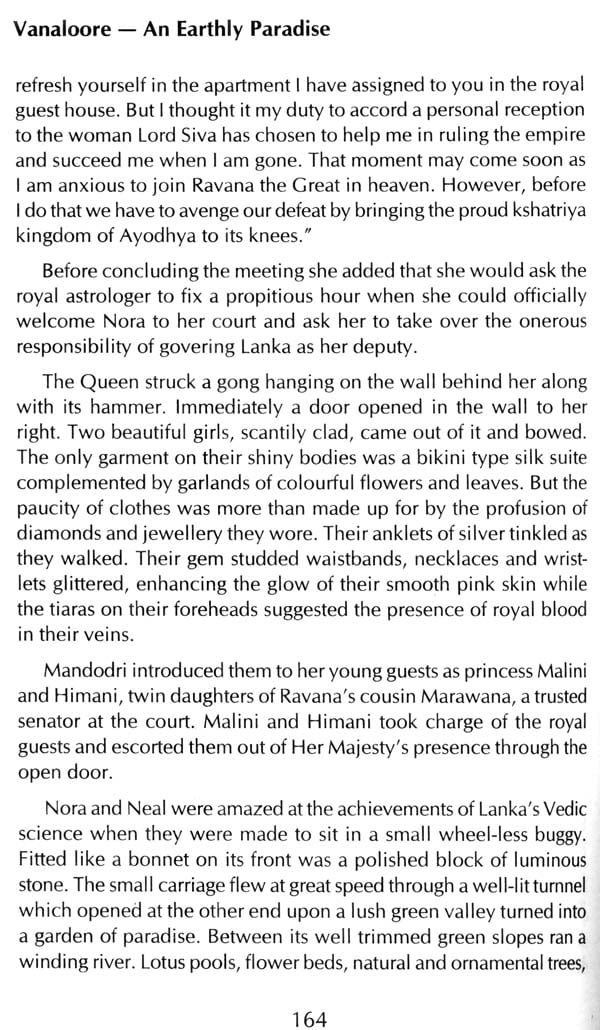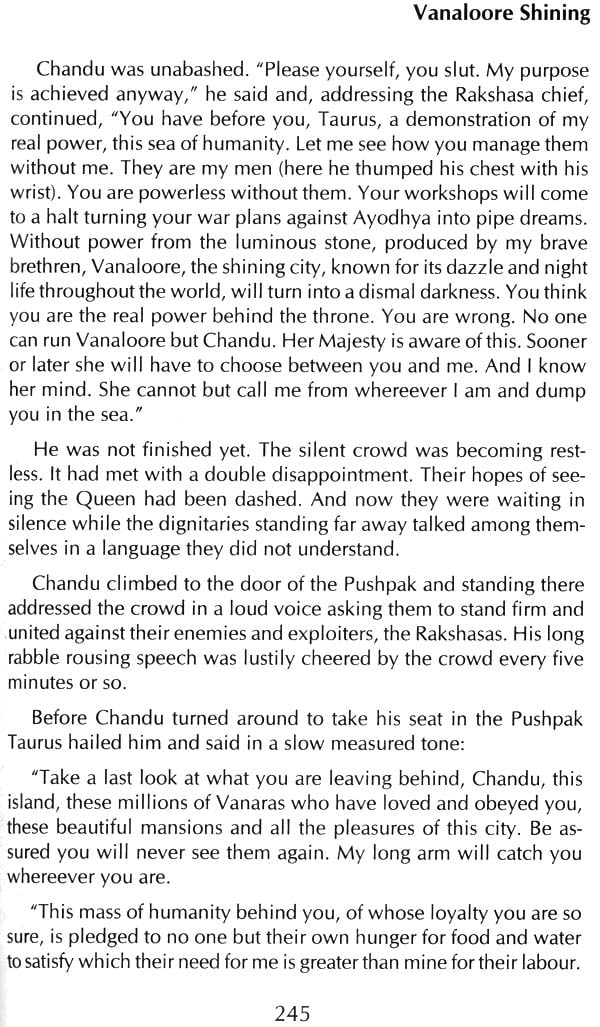
Vanaloore Shining
Book Specification
| Item Code: | NAO948 |
| Author: | M. B. Lal |
| Publisher: | M.B. Lal |
| Language: | English |
| Edition: | 2007 |
| Pages: | 298 (15 B/W Illustrations) |
| Cover: | Paperback |
| Other Details | 8.5 inch X 5.5 inch |
| Weight | 410 gm |
Book Description
All adult rakshasas in Lanka having been killed along with Ravana, their king, by Ram and his Vanara army, their young, sex-starved widows set out for neighbouring islands in search of men they could woo and marry. The leader of this romantic expedition is an intrepid princess of the royal family who would stop at nothing in her quest for a true lover. She finds one at last in a member of the enemy race. Their unholy union leads to cataclysmic events culminating in the founding of a new empire, with its own civilization, on the ruins of the old. Essentially a graphic account of the thrilling adventures of the daring rakshasi princess and her equally brave Vanara lover, 'Vanaloore Shining' is also a reminder that Ravana's imperialist Lanka has been an ever present reality throughout our history and still is. Perhaps this is how its creator, sage-poet Val envisioned it
Why Did They Have To Die? There was an explosion of grief at the death of actor Rajakumar who had won the love and regards of a large section of our people. That he passed away suddenly added to the grief. The mourners were even more incensed as adequate arrangements had not been made for them to pay their last respects to their chosen idol.
Eight persons died in the process, seven in Police firing and one was lynched by the mob. As reported in the Press, the names and background of those who died during Raj Kumar's funeral are: Gopal, aged 27, was working as a mechanic, date of marriage had been fixed, has an aged father who is blind.
Janardan, aged 25, was working in a garment factory, had celebrated the marriage of his sister after obtaining a loan. Shylesh Kumar, aged 28, only son of a security guard, has a sister who has lost both legs.
Yashwanth Shetty, aged 19, garment factory worker, the only son of Suresh Shetty. Amjad Kattimani, aged 25, had arrived in Bangalore from a village in North Karnataka and was working in a very small factory. Wife was pregnant at the time of his death.
Muni Raju, aged 40, was working as a coolie in Kengeri (near Bangalore), survived by wife Radhamma and two daughters. Kumar, aged 22, a carpenter.
Manjunatha Malladi, aged 25, under training with the state Reserve Police, hailed from Savadatti (near Dharwar), the only earning member in the family.
These details indicate the following:
All the dead were men.
All, excepting Muniraju, were in their youth.
Most of them belonged to poor families from backward classes.
None of them was highly educated.
They were working in small factories to earn a living.
Two of them were from North Karnataka. In their villages they had perhaps no land of their own or else had small possessions of land which yielded little to make a livelihood possible. Obviously, they came to the city to find new moorings for their lives.
Excepting only Manjunath, a Malladi who was there to discharge his official duties, none of those who died had any security of job. They had to struggle hard to make both ends meet.
Most of the people who had poured out into the streets that day to mourn Raj had a background of this kind only. While these deaths were happening, Rajkumar himself was endowing life on someone with his eyes donated for the purpose. That he was responsible for the death or eight persons Raj did not know. Likewise, he was giving his eyes to someone unrelated to him in any way.
Life and death, light and darkness were occurring simultaneously. This is symbolic in the sense that it suggests the two-fold impact of cinema culture over the last three quarters of a century in Karnataka.
Why only the socially neglected class went on the streets to express grief is the question. Why were they smashing police vehicles or setting them on fire? May be, some rowdy elements had sneaked into the emotionally surcharged crowd. They were not adorers of Raj Kumar. May be also that among those arrested were many with criminal records as the Police stated. But not all were given to destructive tendencies; nor were they all anti-social elements.
A majority of them happened to be marginalised people in our economic political system with its perverted ideas of development. The emotional display by them, the destruction they caused, were bad and condemnable.
But there was this dimension to all that: the latent frustration and anger towards the established system.
At the time of cremation there were scenes of anarchy and bloodshed no doubt. But one cannot forget the fact that the lower classes of people wedded to secularism were expressing their love for a person unmindful of his caste. The affection showered on him for three generations was unprecedented. When he was alive and also when he died. This was not merely the personal attainment of Raj Kumar but also the result of the immense magnetic power that the film medium has.
Those who formed the crowd that day were not all Bangaloreans. Poor people had come all the way by buses spending money for it. The caste identities as well as the economic background of the dead bear this out. Their secularism did not mean renouncing caste; but they did not care for the caste of the dead artiste. The lower castes have this tradition within the framework of their castes: visiting the house of the dead, seeing the dead body, partaking of the grief of the family of the dead, participating in the funeral, going to the cemetery to salute the dead, etc.
The irony of it is that there were some tufted Brahmins to cremate Raj while the tradition of his caste is to bury the dead. Why they were there is anybody's guess. As it happened, however, people did not allow the elite class to pose for the cameras, nor did they allow the priests to have any say. They buried the dead themselves . The cinema culture which made the hero an idol devised its own mode of burying the dead its own peculiar secular way.
| Foreword-Why Did They Have To Die? | 5 | |
| 1 | A Marriage with a difference | 21 |
| 2 | When Stars Meet History Repeats | 39 |
| 3 | A Unique Manhunt | 49 |
| 4 | Nora's Great Secret | 63 |
| 5 | Search For New Hubsbands | 75 |
| 6 | War Drums | 93 |
| 7 | Vanaras Discover Themselves | 103 |
| 8 | The Earthquake | 111 |
| 9 | A Tigress Licks Her Wounds | 123 |
| 10 | Beyond Earth in a Toy Plane | 133 |
| 11 | Vanaloore — An Earthly Paradise | 153 |
| 12 | Gambling House Windfall for Princess | 171 |
| 13 | When Science is King | 205 |
| 14 | Backlash | 219 |
| 15 | The Queen Relents before True Love | 255 |
| 16 | Why Bangalore? | 271 |
| 17 | Jai Vaastu! | 277 |
| Afterword - The New Maharajas | 281 |











